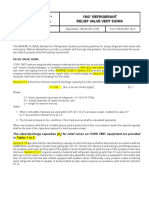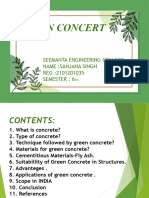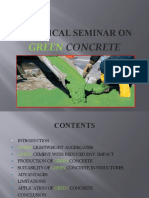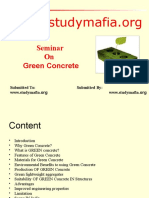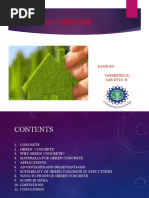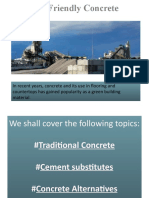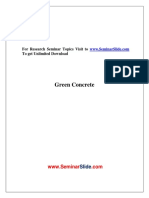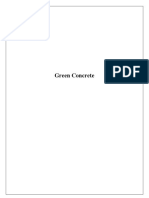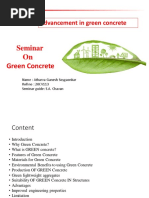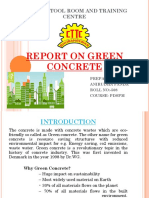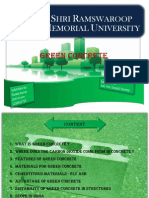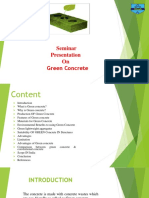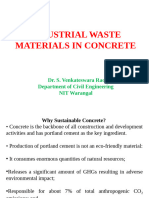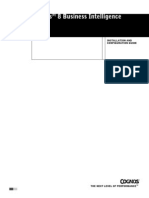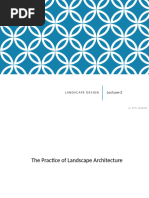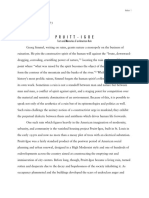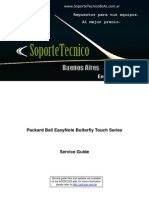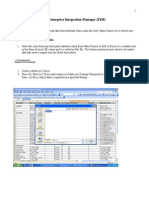0 ratings0% found this document useful (0 votes)
167 viewsSeminar Report ON: 7 Sem, B.Tech, Civil Engineering
Seminar Report ON: 7 Sem, B.Tech, Civil Engineering
Uploaded by
Gautam PatnaikThis document is a seminar report on green concrete presented by a 7th semester civil engineering student. It defines green concrete as concrete made with waste materials that requires less energy and emits less carbon dioxide than traditional concrete. The report discusses the origins of green concrete, its materials like fly ash, mix design, applications in construction, and advantages like reduced environmental impact. It concludes that green concrete has significant potential through waste reuse and provides an economical and environmentally friendly alternative to traditional concrete.
Copyright:
© All Rights Reserved
Available Formats
Download as PPTX, PDF, TXT or read online from Scribd
Seminar Report ON: 7 Sem, B.Tech, Civil Engineering
Seminar Report ON: 7 Sem, B.Tech, Civil Engineering
Uploaded by
Gautam Patnaik0 ratings0% found this document useful (0 votes)
167 views25 pagesThis document is a seminar report on green concrete presented by a 7th semester civil engineering student. It defines green concrete as concrete made with waste materials that requires less energy and emits less carbon dioxide than traditional concrete. The report discusses the origins of green concrete, its materials like fly ash, mix design, applications in construction, and advantages like reduced environmental impact. It concludes that green concrete has significant potential through waste reuse and provides an economical and environmentally friendly alternative to traditional concrete.
Original Description:
Presentation
Original Title
greengautam-1
Copyright
© © All Rights Reserved
Available Formats
PPTX, PDF, TXT or read online from Scribd
Share this document
Did you find this document useful?
Is this content inappropriate?
This document is a seminar report on green concrete presented by a 7th semester civil engineering student. It defines green concrete as concrete made with waste materials that requires less energy and emits less carbon dioxide than traditional concrete. The report discusses the origins of green concrete, its materials like fly ash, mix design, applications in construction, and advantages like reduced environmental impact. It concludes that green concrete has significant potential through waste reuse and provides an economical and environmentally friendly alternative to traditional concrete.
Copyright:
© All Rights Reserved
Available Formats
Download as PPTX, PDF, TXT or read online from Scribd
Download as pptx, pdf, or txt
0 ratings0% found this document useful (0 votes)
167 views25 pagesSeminar Report ON: 7 Sem, B.Tech, Civil Engineering
Seminar Report ON: 7 Sem, B.Tech, Civil Engineering
Uploaded by
Gautam PatnaikThis document is a seminar report on green concrete presented by a 7th semester civil engineering student. It defines green concrete as concrete made with waste materials that requires less energy and emits less carbon dioxide than traditional concrete. The report discusses the origins of green concrete, its materials like fly ash, mix design, applications in construction, and advantages like reduced environmental impact. It concludes that green concrete has significant potential through waste reuse and provides an economical and environmentally friendly alternative to traditional concrete.
Copyright:
© All Rights Reserved
Available Formats
Download as PPTX, PDF, TXT or read online from Scribd
Download as pptx, pdf, or txt
You are on page 1of 25
SEMINAR REPORT
ON
“
PRESENTED BY
7TH SEM, B.TECH, CIVIL ENGINEERING
CONTENTS
• Introduction to concrete
• Green concrete- meaning and origin
• Why green concrete?
• Techniques followed by green concrete
• Requirements of green concrete
• Materials for green concrete
• Cementitious materials- fly ash
• Mix design
• Application of green concrete
• Advantages of green concrete
• Conclusion
CONCRETE
Concrete is the mixture of cement, sand and
water and coarse aggregates which can be
poured into formwork to form a hard structure.
TYPES OF CONCRETE
Reinforced cement concrete(R.C.C)
Plain cement concrete(P.C.C)
Ready-mix concrete
Light weight concrete
Fibre reinforced concrete
Green concrete
GREEN CONCRETE-ORIGIN
→Green concrete is a revolutionary topic in the
history of concrete industry, this was first
invented in Denmark in the year of 1998.
→Green concrete is the type of concrete which is
much like the conventional concrete but the
production of such concrete requires minimum
amount of energy and causes least harm to the
environment.
→It has nothing to do with colour but represents
the environment which surrounds us.
WHAT IS GREEN CONCRETE
→It is made with concrete waste and uses less
energy in it’s production & produces less
carbon dioxide than normal concrete.
→It is eco-friendly in nature and it’s main aim is
to reduce environmental hazards. EX- energy
saving, 𝑐𝑜2 emissions, waste water.
→Concrete waste like slag, power plant, mining
and quarrying wastes etc.
WHY GREEN CONCRETE
• Green concrete constitutes of materials which are
partial or complete replacements for cement or
fine or coarse aggregates.
• The substitution material can be of waste or
residual products in the manufacturing process.
_______________________________________
The main ingredient in the concrete is cement
and it consists of limestone(calcium carbonate,
𝑐𝑎𝑐𝑜3 )
During manufacturing of cement, it’s
ingredients are heated to about 800-1000°C.
During the process carbon dioxide is driven
off.
Approximately 1kg of cement releases about
900gms of carbon dioxide in the atmosphere.
Therefore, green concrete came into existence
to reduce the emission of carbon dioxide.
TECHNOLOGY FOLLOWED BY GREEN
CONCRETE
• It should follow the technique of REDUCE-REUSE-
RECYCLE.
• Reduce the use of natural resources such as
limestone, shale, clay, and natural river sand.
• Use of waste materials
• Materials required for concrete can be recycled.
OBJECTIVES
The main objective of using green concrete is
making eco-friendly structures and to contruct and
develop in a sustainable manner without
destruction of natural resources.
REQUIREMENTS OF GREEN CONCRETE
• The concrete should have the following requirements to say
it is a “GREEN CONCRETE”.
1. Workability, which is basically the ease with which
concrete can be compacted fully without segregation and
bleeding.
2. Segregation, which is basically separation of coarse
particles from the green concrete.
3. Bleeding, which is the appearance of water along with
cement particles on the surface of freshly laid concrete.
4. Harshness, which is the resistance offered by concrete to
it’s surface finish.
MAERIALS FOR GREEN CONCRETE
Recycled demolition waste aggregates
Recycle concrete aggregate
Blast Furnace Slag(BFS)
Manufactured sand
Glass aggregate
Fly ash
CEMENTITIOUS MATERIALS
• FLY ASH:-
Fly ash is a by product produced
during the operation of coal fired plants. The
finely divided particles from the exhaust gases
are collected in electro static precipitators.
These particles are called fly ash.
• Advantages of using fly ash in concrete:-
1. Utilization of fly ash as a part replacement of
cement or as a mineral admixture in concrete
saves on cement and hence the emission of
𝑐𝑜2 .
2. Use of good quality fly ash in concrete has
shown remarkable improvement in durability
of concrete, especially in aggressive
environment.
• Some of the technical benefits of the use of fly
ash in concrete are:
a) Higher ultimate strength
b) Increased durability
c) Improved workability
d) Reduced bleeding
e) Increased resistance to alkali-silica reactivity.
f) Reduced shrinkage
• Green lightweight aggregates:
Synthetic lightweight aggregates produced from
environmental waste is a viable new source of
structural aggregate material.
The use of structural grade lightweight concrete
reduces the self load of a structure considerably and
permits larger precast units to be handled.
Water absorption of the green concrete is large but the
crushing strength of the resulting concrete can be high.
The 28 day cube compressive strength of the resulting
lightweight aggregate concrete with density of 1590 kg
/m3 and respective strength of 34 Mpa.
MIX DESIGN
The concrete mix design method for such
concrete is the same as for conventional
concrete.
The constitute materials shown in figure must
pack themselves in such a manner that they
occupy minimum volume or give minimum voids
in concrete.
For getting a dense or impervious green concrete
all voids must be placed with smaller particles or
next type of materials.
APPLICATIONS OF GREEN CONCRETE
• Following are the major applications of green
concrete:-
1) It is used in construction of bridges.
2) It is widely used in the construction of
building.
3) Used in the construction of column
4) Can be used road construction
Queensland University of Australia
• Sustainability of green concrete in structures:-
1) Reduce the dead weight of a structure from 5 tons to
about 3.5 tons
2) Reduce crane age load, allow handling, lifting flexibility
with lighter weight
3) Good thermal and fire resistance
4) Better sound insulation than the traditional granite rock.
5) Reduction of the concrete industry’s 𝑐𝑜2 emission by 30%
6) Increased concrete industry’s use of waste products by
20%
7) No environmental pollution and sustainable development
8) Green concrete requires less maintenance & repairs
ADVANTAGES OF GREEN CONCRETE
1) Better workability than conventional concrete.
2) Reduction in shrinkage & creep.
3) The heat of hydration of green concrete is
significantly lower than traditional concrete.
4) Uses local and recycled materials in concrete.
5) Good thermal and fire resistant.
6) Compressive strength and flexural behaviour is
fairly equal to that of the conventional concrete.
7) Economical and cheap.
• Limitation
1) By using stainless steel, cost of reinforcement
increases.
2) Structures constructed with green concrete
have comparatively less life than structures
with conventional concrete.
3) Split tension of green concrete is less than
that of conventional concrete.
4) Water absorption is high
• Scope in India and the construction industry
Green concrete is a revolutionary topic in the
history of concrete industry. As green concrete is
made with concrete wastes, it does take more
time to come in India because of industries
having problem to dispose wastes and also
having reduced environmental impact with
reduction in 𝑐𝑜2 emission.
CONCLUSION
• There is significant potential in waste materials to produce
green concrete.
• The replacement of traditional ingredients of concrete by
waste materials and by products give an opportunity to
manufacture economical and environment friendly concrete.
• Partial replacement of ingredients by using waste materials
and admixtures shows better compressive and tensile
strength, improved sulphate resistance, decreased
permeability and improved workability.
• The cost per unit volume of concrete with waste material like
quarry dust lower than the corresponding control concrete
mixes.
• A detail life cycle analysis of green concrete by considering
various parameters is very much necessary to understand the
resultant concrete properties.
You might also like
- Literature Review - A Sustainable Vernacular ArchitectureDocument5 pagesLiterature Review - A Sustainable Vernacular ArchitectureResti PiutantiNo ratings yet
- Beauty Parlour Management SystemDocument31 pagesBeauty Parlour Management SystemSneha Firangi79% (19)
- Manual Conectare ErpDocument82 pagesManual Conectare Erpe-noreplyNo ratings yet
- 160.84-AD1-Application Data-YMC2 Refrigerant Relief Valve Vent SizingDocument6 pages160.84-AD1-Application Data-YMC2 Refrigerant Relief Valve Vent SizingCarl CrowNo ratings yet
- Final Pts 12cc348Document233 pagesFinal Pts 12cc348shantivan50% (2)
- Green Concrete Seminar TopicDocument21 pagesGreen Concrete Seminar TopicAdesh DepangiNo ratings yet
- Greenconcrete 151201205108 Lva1 App6891Document21 pagesGreenconcrete 151201205108 Lva1 App6891Judin MathewsNo ratings yet
- Green Concrete: Presented By: Presented ToDocument19 pagesGreen Concrete: Presented By: Presented ToSatyam SatyaNo ratings yet
- Power Point PresentationDocument23 pagesPower Point PresentationBabulal PatraNo ratings yet
- Green ConcreteDocument15 pagesGreen Concrete19pgcl003TARANGKUMAR LAKHANINo ratings yet
- Technical Seminar On: GreenDocument17 pagesTechnical Seminar On: GreenMohak Nagrani100% (4)
- Project On Green ConcreteDocument18 pagesProject On Green ConcreteKaushiki KambojNo ratings yet
- Green ConcreteDocument11 pagesGreen ConcreteVaishnavi MundlodNo ratings yet
- Civil Green ConcreteDocument18 pagesCivil Green Concretesharukh88% (8)
- PROJECT ON Replacement of Cement by Fly AshDocument18 pagesPROJECT ON Replacement of Cement by Fly AshKaushiki KambojNo ratings yet
- Green CementDocument15 pagesGreen Cementsaranya rNo ratings yet
- Green CementDocument15 pagesGreen Cementsaranya rNo ratings yet
- Green CementDocument15 pagesGreen Cementsaranya rNo ratings yet
- In Recent Years, Concrete and Its Use in Flooring and Countertops Has Gained Popularity As A Green Building MaterialDocument20 pagesIn Recent Years, Concrete and Its Use in Flooring and Countertops Has Gained Popularity As A Green Building MaterialSuman GaonkarNo ratings yet
- Green ConcreteDocument18 pagesGreen ConcreteAman LonareNo ratings yet
- Civil Green ConcreteDocument18 pagesCivil Green ConcreteShreekant KeraiNo ratings yet
- Civil Green ConcreteDocument16 pagesCivil Green ConcretereshmaNo ratings yet
- Green Concrete: WWW - SeminarDocument12 pagesGreen Concrete: WWW - SeminarSuraj Deb BarmaNo ratings yet
- Seminar On Green Concrete: Submitted To: Submitted byDocument18 pagesSeminar On Green Concrete: Submitted To: Submitted byPalla JyothirmaiNo ratings yet
- Seminar On Green Concrete: Submitted To: Submitted byDocument17 pagesSeminar On Green Concrete: Submitted To: Submitted byAbbiNo ratings yet
- Civil Green ConcreteDocument17 pagesCivil Green Concretehopam38313No ratings yet
- Green Concrete SeminarDocument20 pagesGreen Concrete SeminarSelva Prakash67% (9)
- Green ConcreteDocument18 pagesGreen ConcreteSonu UmarwalNo ratings yet
- Civil Green ConcreteDocument18 pagesCivil Green ConcreteVishal BahureNo ratings yet
- Civil Green ConcreteDocument18 pagesCivil Green ConcreteMahmoud MostafaNo ratings yet
- Green ConcreteDocument23 pagesGreen ConcreteNisha KaundalNo ratings yet
- Green ConcreteDocument12 pagesGreen Concretevaishnavi yedur100% (1)
- Green ConcreteDocument22 pagesGreen ConcreteQseem Khan100% (1)
- Civil Green ConcreteDocument18 pagesCivil Green ConcreteAtharva SoygaonkarNo ratings yet
- Green ConcreteDocument22 pagesGreen ConcreteSyafiq ArtNo ratings yet
- Rigid Pavement Pavement Design2Document4 pagesRigid Pavement Pavement Design2LIFE HACKERSNo ratings yet
- The Concrete Which Is Made Using Wastes Which Is Eco NewDocument14 pagesThe Concrete Which Is Made Using Wastes Which Is Eco Newtejutejas721No ratings yet
- Report On Green Concrete: Central Tool Room and Training CentreDocument14 pagesReport On Green Concrete: Central Tool Room and Training CentreRithik singhNo ratings yet
- Green ConcreteDocument14 pagesGreen ConcretePankajKumar100% (1)
- Seminar PPT On Green ConcreteDocument16 pagesSeminar PPT On Green ConcreteSandeep Meena75% (8)
- Pruthwiraj Paikeray PPT On Green ConcreteDocument14 pagesPruthwiraj Paikeray PPT On Green Concretepruthwiraj2023No ratings yet
- Green ConcreteDocument12 pagesGreen ConcreteNikhil GosaviNo ratings yet
- DEVIDocument10 pagesDEVIDibyaranjan DasNo ratings yet
- PE003Document38 pagesPE003Gogireddy Srinivasareddy1346No ratings yet
- GREEN CONCRETE SEMINAR 4th YearDocument16 pagesGREEN CONCRETE SEMINAR 4th Yearrahulboro304No ratings yet
- Green ConcreteDocument17 pagesGreen Concretegokula124No ratings yet
- Green ConcreteDocument14 pagesGreen ConcreteChitransh RajatNo ratings yet
- Green ConcreteDocument11 pagesGreen ConcreteJagruti hanvateNo ratings yet
- Pptofgreenconcrete 161220165229Document23 pagesPptofgreenconcrete 161220165229BanNo ratings yet
- Green Concrete: A Seminar Report OnDocument13 pagesGreen Concrete: A Seminar Report OnUmange RanasingheNo ratings yet
- Green ConcreteDocument13 pagesGreen ConcreteSanket Chaudhari100% (1)
- Seminar Presentation On Green ConcreteDocument22 pagesSeminar Presentation On Green ConcreteMOHINI JAISWALNo ratings yet
- Green Concrete: Dayananda Sagar College of EngineeringDocument8 pagesGreen Concrete: Dayananda Sagar College of EngineeringSharanu PujariNo ratings yet
- Green ConcreteDocument17 pagesGreen ConcreteAyush GargNo ratings yet
- Green ConcreteDocument17 pagesGreen ConcreteAyush GargNo ratings yet
- 21.industrial Waste Materials in ConcreteDocument30 pages21.industrial Waste Materials in ConcreteraviciviltNo ratings yet
- Eng-Green Concrete Efficient and Eco-Friendly-Chirag GargDocument6 pagesEng-Green Concrete Efficient and Eco-Friendly-Chirag GargImpact JournalsNo ratings yet
- Sustainable Planning & Architecture (Unit - 3)Document51 pagesSustainable Planning & Architecture (Unit - 3)Minni ImmanuelNo ratings yet
- 1 Introduction Sustainable ConstructionDocument22 pages1 Introduction Sustainable ConstructionHellin DelNo ratings yet
- Why Green Concrete?: - Huge Impact On Sustainability - Most Widely Used Material On EarthDocument33 pagesWhy Green Concrete?: - Huge Impact On Sustainability - Most Widely Used Material On EarthShantanu JhaNo ratings yet
- 118Document9 pages118Suhail KhanNo ratings yet
- Sustainability in Structural Concrete DesignFrom EverandSustainability in Structural Concrete DesignJorge de BritoNo ratings yet
- Clean Ironmaking and Steelmaking Processes: Efficient Technologies for Greenhouse Emissions AbatementFrom EverandClean Ironmaking and Steelmaking Processes: Efficient Technologies for Greenhouse Emissions AbatementNo ratings yet
- Self-healing Ceramic Matrix Composites: A MonographFrom EverandSelf-healing Ceramic Matrix Composites: A MonographNo ratings yet
- South Florida Harmon HomesDocument24 pagesSouth Florida Harmon HomesharmonmediagroupNo ratings yet
- Inst CR WinuxDocument242 pagesInst CR Winuxdprabhu100% (3)
- Plumbing Code TerminologyDocument21 pagesPlumbing Code Terminologyaseec2012_agustinNo ratings yet
- Lecture 2Document60 pagesLecture 2Meron BerihunNo ratings yet
- Final Report CompressedDocument185 pagesFinal Report Compressedapi-302702920100% (2)
- Parabola ProjectDocument9 pagesParabola ProjectsahirxxNo ratings yet
- Huawei E5186 Datasheet SpecificationsDocument24 pagesHuawei E5186 Datasheet SpecificationsRubvly TanNo ratings yet
- DES-3226L DsDocument3 pagesDES-3226L DsknighttuxNo ratings yet
- Design of Prestressed Concrete Bridges: Done By: Hadeel Sameeh "Ahmed Hussien"Document52 pagesDesign of Prestressed Concrete Bridges: Done By: Hadeel Sameeh "Ahmed Hussien"Bara AlsayedNo ratings yet
- Sim508 Atc V1.00Document180 pagesSim508 Atc V1.00api-3736768100% (3)
- SANGFOR WANO User Manual v9 PDFDocument227 pagesSANGFOR WANO User Manual v9 PDFmartiniNo ratings yet
- Edifice VillaDocument9 pagesEdifice Villam3788999No ratings yet
- AAF General Brochure - 0411 PDFDocument24 pagesAAF General Brochure - 0411 PDFLBNo ratings yet
- Pruitt Igoe FactsDocument13 pagesPruitt Igoe Factsses_707No ratings yet
- Course of Study Application Development - Programmer (It-010-2) Module 1: Evaluate System SpecificationDocument5 pagesCourse of Study Application Development - Programmer (It-010-2) Module 1: Evaluate System SpecificationGevita GvNo ratings yet
- VGA Video Signal FormatDocument3 pagesVGA Video Signal Formatpirozy100% (1)
- Voip LecDocument26 pagesVoip LecravinderslathwalNo ratings yet
- RmsDocument34 pagesRmssauvishNo ratings yet
- Autoship Manual 10Document162 pagesAutoship Manual 10George PonpykaNo ratings yet
- Embedded Linux Kernel and Drivers PDFDocument433 pagesEmbedded Linux Kernel and Drivers PDFaashray bNo ratings yet
- Education: Shakeeb AhmedDocument1 pageEducation: Shakeeb AhmedShakeeb AhmedNo ratings yet
- GprsDocument18 pagesGprsSanjaya100% (1)
- 26 Service Manual - Packard Bell - Easynote Butterfly TouchDocument207 pages26 Service Manual - Packard Bell - Easynote Butterfly TouchSoporte Tecnico Buenos AiresNo ratings yet
- EIM ProcessDocument11 pagesEIM ProcesskittusiebelNo ratings yet
- Designation Activity Quantity Units Productivity Rates Duration (Days)Document2 pagesDesignation Activity Quantity Units Productivity Rates Duration (Days)Bryle James NangleganNo ratings yet




